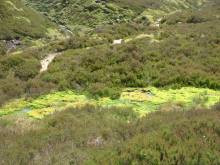Degeneration of the upland moors
- Burning, grazing, drainage and air pollution affect plant communities.
- Climatic fluctuations, fire and draining cause the drying of the peat's surface which changes the species composition.
Sphagnum spp.

This once common group of species throughout the wetter bog areas was found alongside cotton grass and on very wet peat haggs is now a relative rarity on the upland moors.
The loss of Sphagnum species and its replacement with Hair's-tail cotton grass can be correlated with increased air pollution at the time of the Industrial Revolution, as the Peaks are surrounded by large industrial conurbations.
Sulphur dioxide from acid rain is the most damaging air pollutant to Sphagnum species, whilst Hair's-tail cotton grass has been shown to be resistant to present sulphur levels.
The loss of these bog "carpets", once anchored by the now much absent Sphagnum species may be connected to the decline of other species including sundews (Drosera rotundifolia & Drosera intermedia) and bog rosemary (Andromeda polifolia).
Now move on to the peat pages to find out about the blanket peat underlying the vegetation.